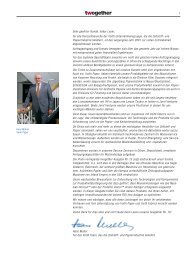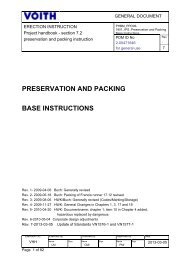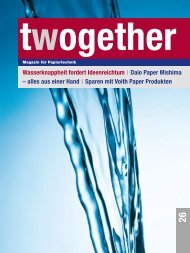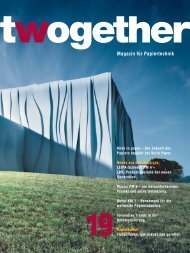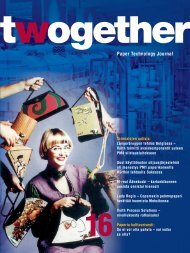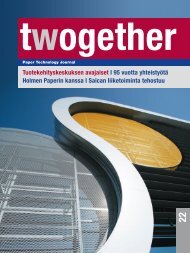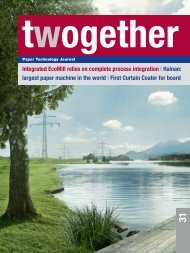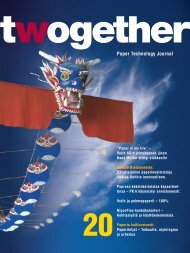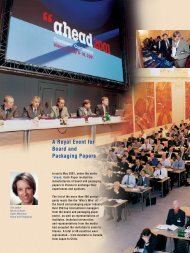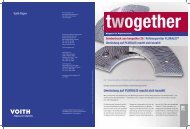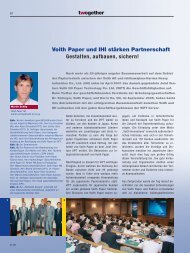Paper Technology Journal 19 - Voith
Paper Technology Journal 19 - Voith
Paper Technology Journal 19 - Voith
Create successful ePaper yourself
Turn your PDF publications into a flip-book with our unique Google optimized e-Paper software.
2<br />
forms the ice into vapor that can then escape<br />
and leave the book dry.<br />
A load of books weighing up to a ton is<br />
sealed into a pressure chamber, the temperature<br />
inside lowered to <strong>19</strong>2 degrees<br />
Celsius below zero and the air pressure,<br />
which is normally in the region of 1,000<br />
millibars, reduced to below 7 millibars.<br />
Instead of melting, the ice begins to ‘vaporize’<br />
in these conditions, and in this<br />
state can easily be extracted from the<br />
chamber. The normal atmospheric pressure<br />
is then restored and the temperature<br />
allowed to rise gradually to 20 degrees<br />
Celsius.<br />
Depending on the number of books being<br />
processed and their formats, the treat-<br />
3<br />
ment process may be over within a few<br />
hours, but can also take two to three<br />
days. Afterwards, the books are absolutely<br />
dry.<br />
The last stage in their treatment involves<br />
the removal of residual dirt by hand.<br />
Rows of work booths have been installed<br />
beneath an air extraction system, and<br />
ZFB staff armed with fine brushes turn<br />
the pages of each book with great care<br />
and remove the mixture of ash and limewash<br />
dust that the fire extinguishing water<br />
removed from the shelves, ceilings<br />
and walls.<br />
This treatment of the books completes<br />
the task that the ZFB has been commissioned<br />
to carry out.<br />
67<br />
Many of the ‘patients’ have already been<br />
returned to Weimar, and now confront<br />
the experts and restoration staff of the<br />
Anna Amalia Library with some difficult<br />
decisions: what further restoration measures<br />
should be applied to them, and in<br />
what order of priority. One thing is certain:<br />
many years will elapse and extensive<br />
financial support will be needed before<br />
this unique historic heritage can re-open<br />
for academic study or for the general<br />
public. It is doubtful whether the final<br />
traces of the fire will ever be eliminated.<br />
Following this spectacular rescue operation,<br />
the ZFB will return to its normal<br />
day-to-day book preservation activities,<br />
and we can indeed be grateful if rectifying<br />
fire damage remains one of its more<br />
exceptional activities.<br />
Fig. 1: Damaged books from the Duchess<br />
Anna Amalia Library in Weimar, Germany.<br />
Fig. 2: Freeze drying damaged documents.<br />
Fig. 3: Removing ash and lime.<br />
<strong>19</strong>/05<br />
1



